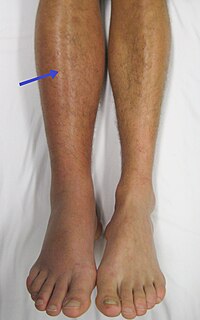
Photo from wikipedia
OBJECTIVES To explore the key genes, and correlated pathways in venous thromboembolism (VTE) via bioinformatic analysis, and expected our findings could contribute to the development of new biomarkers and therapeutic… Click to show full abstract
OBJECTIVES To explore the key genes, and correlated pathways in venous thromboembolism (VTE) via bioinformatic analysis, and expected our findings could contribute to the development of new biomarkers and therapeutic target for VTE. METHODS Two VTE-related microarray expression profiles (GSE48000 and GSE19151) were downloaded from the Gene Expression Ominibus (GEO) database. Differentially expressed genes (DEGs) were analyzed using limma package, and overlapping DEGs were identified form the above two expression profiles. Then, Gene Ontology (GO) and Kyoto Encyclopedia of Genes and Genomes (KEEG) pathway enrichment analyses were performed by DAVID. Protein-protein interaction (PPI) network was constructed by using STRING and visualized with Cytoscape. Furthermore, module analysis plus centrality analysis of the PPI network were executed to identify the potential key genes. Finally, the pathway analysis was performed using GenCLiP 3.0. RESULTS A total of 173 DEGs (125 upregulated and 48 downregulated) were identified. GO analysis demonstrated that DEGs were mainly enriched in viral life cycle, ribosome and structural constituent of ribosome. Meanwhile, KEGG pathway analysis showed that these genes were enriched in ribosome, Parkinson's disease and cell cycle. Additionally, one most significant module and 12 hub genes were found. Finally, 6 key genes, namely ISG15, RPS15A, MRPL13, ICT1, MRPL15 and RPLP0, with high centrality features were identified. These key genes were mainly involved in translation, metabolism of proteins and ribosome pathway. CONCLUSIONS In summary, these 6 identified genes and correlated pathways should play an important role in VTE, which can provide new insight into the molecular mechanism, potential biomarkers and therapeutic targets associated with VTE.
Journal Title: Annals of vascular surgery
Year Published: 2021
Link to full text (if available)
Share on Social Media: Sign Up to like & get
recommendations!